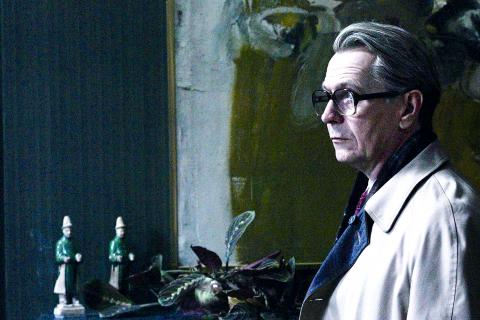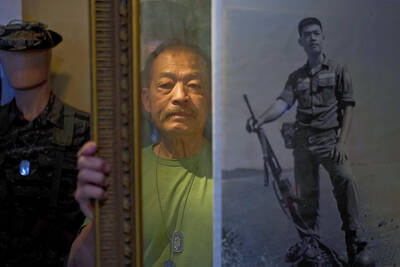Dread throbs like a heartbeat in Tinker, Tailor, Soldier, Spy, a superb new adaptation of the 1974 spy novel by John le Carre. It’s a deep pulse that maintains its insistent rhythm throughout the film’s murmured conversations, life-and-death office intrigues, violence and yearning loves. The throbbing does a number on your nervous system — this is a movie you watch on high alert — and brings you into the state of mind that can feel like a state of siege and goes by the name of British secret service, or just the Circus. For those inside the intelligence service, like George Smiley, played with delicacy and understated power by Gary Oldman, knowledge is power, but so too is fear.
The story, skillfully mined from Le Carre’s labyrinthine book and set in 1973, is a pleasurably sly and involving puzzler — a mystery about mysteries within mysteries. The head of the service, known as Control (John Hurt), believes that there’s a Soviet agent, a mole, among the agency’s elite. His main suspects include his closest aide, Smiley, along with Percy Alleline (Toby Jones), Toby Esterhase (David Dencik), Roy Bland (Ciaran Hinds) and Bill Haydon (Colin Firth). To find the mole, Control secretly sends Jim Prideaux (Mark Strong), who runs the agency’s scalp hunters (field agents with dirty, sometimes bloodied hands), to Hungary to retrieve information. But Prideaux, in an agonizing botch-up, is shot, and Control, already politically weak, is fired along with Smiley.
Le Carre’s seventh novel and the first in his Karla trilogy, Tinker, Tailor is set against a geopolitical (and movie) moment that is almost quaintly, reassuringly old-fashioned, a time when enemy agents had names like Boris, and a red flag with a hammer and sickle made the ideological and political stakes clear. It’s a world of secrets and lies, shadows and light, illusions and sordid truths, loyalties and perverse betrayals that the director Tomas Alfredson conjures up in the film’s uneasy opening in Control’s apartment, a cluttered warren fogged over by cigarette smoke. “There’s a rotten apple,” Control says to Prideaux, drawing on a cigarette as he explains his theory about the mole, the folds in Hurt’s magnificent face sagging a bit lower.

Photo courtesy of Studio Canal
That face, a crevassed landscape that suggests sorrow and history, has the granitic grandeur of W.H. Auden in his later life. In tandem with Hurt’s sonorously melancholic voice (and its useful undertones of hysteria), it is a face that, when used by a filmmaker like Alfredson, speaks volumes about a character who would otherwise take reams of written dialogue to discover. But unlike the 1979 British television version with Alec Guinness that ran a dutiful 350 minutes, Alfredson doesn’t enjoy the luxury of literalness. Instead, working from Bridget O’Connor and Peter Straughan’s intelligent script, this terrifically talented director (Let the Right One In) distills the novel’s essence, finding images, as with the Circus’s chessboardlike walls, that express what the film’s words and characters don’t.
Smiley, who doesn’t say a word until 18 minutes in (“I’m retired”), re-enters the spy game at the behest of a government minister, Oliver Lacon (Simon McBurney). Lacon has received alarming information from Ricki Tarr (Tom Hardy), another scalp hunter, who has met a Soviet woman, Irina (Svetlana Khodchenkova), with apparent knowledge of the mole. Using Tarr’s lead and with the help of a trusted Circus agent, Peter Guillam (Benedict Cumberbatch), Smiley begins ferreting out the mole, spying on the spies. He also uncovers an operation called Witchcraft and runs up against an arch-villain, Karla, a Soviet intelligence officer, in an almost ruthlessly unromantic vision of empire dreams that unfolds in sad, grubby rooms where the flowered wallpaper is sometimes splashed with blood.
Despite that brutality, Tinker, Tailor is suffused with longing and love — for a country, a cause, a lover, a father — a theme that poignantly surfaces at a boys’ school where Prideaux re-emerges and which, in its cloistered quality, mirrors both the big boys’ club that is the Circus and recalls another school that haunts the narrative. Tinker, Tailor is partly based on the case of Kim Philby, one of a handful of British spies and Cambridge University alumni who were recruited by the Soviets in the 1930s. (Le Carre, born David John Moore Cornwell, was a British spy whose cover was blown by Philby.) At the school Prideaux meets a lonely student, Bill Roach (William Haddock), a moon-faced outsider whom Prideaux calls “a good watcher,” a description that, given the sadness that cloaks the story’s many watchers, feels chilling.

Photo courtesy of Studio Canal
First among the watchers, of course, is Smiley, the anti-Bond described by Le Carre in Tinker, Tailor as looking like “one of London’s meek who do not inherit the earth.” Since the 1979 mini-series, the character has been synonymous with Guinness’ performance, as Le Carre has acknowledged. (Guinness resumed the role in the 1982 mini-series Smiley’s People.) Oldman, now mostly known for his small, sharp turns in big movies, playing Harry Potter’s godfather, Sirius Black, and James Gordon in the Batman movies, wisely doesn’t reinvent Smiley. Rather — as hinted in an early scene of Smiley buying the kind of oversize eyeglasses that Guinness wore — he and Alfredson have opted to build on the original interpretation, using it as a foundational text. (Guinness’ turn is the Torah; Oldman’s the Talmud.)
It’s a fascinatingly gripping performance that doesn’t so much command the screen, dominating it with shouts and displays of obvious technique, as take it over incrementally, an occupation that echoes Smiley’s steady incursion into the mole’s lair. Again and again, as he does with the other watchers, Alfredson places Smiley on one side of a window, looking out at a world that he both belongs to and remains very much outside of. There’s a sense throughout that Smiley, preoccupied with thoughts of his errant, faithless wife, Ann (Katrina Vasilieva, never viewed in full), doesn’t just live in a place apart but also in a kind of dream. Yet like the old Circus — a lost world seen in the intermittent flashbacks to a holiday party that, when pieced together, reveal so much, including who loved whom and who was betrayed — Ann is an illusion that Smiley fights for.

As we live longer, our risk of cognitive impairment is increasing. How can we delay the onset of symptoms? Do we have to give up every indulgence or can small changes make a difference? We asked neurologists for tips on how to keep our brains healthy for life. TAKE CARE OF YOUR HEALTH “All of the sensible things that apply to bodily health apply to brain health,” says Suzanne O’Sullivan, a consultant in neurology at the National Hospital for Neurology and Neurosurgery in London, and the author of The Age of Diagnosis. “When you’re 20, you can get away with absolute

When the South Vietnamese capital of Saigon fell to the North Vietnamese forces 50 years ago this week, it prompted a mass exodus of some 2 million people — hundreds of thousands fleeing perilously on small boats across open water to escape the communist regime. Many ultimately settled in Southern California’s Orange County in an area now known as “Little Saigon,” not far from Marine Corps Base Camp Pendleton, where the first refugees were airlifted upon reaching the US. The diaspora now also has significant populations in Virginia, Texas and Washington state, as well as in countries including France and Australia.

On April 17, Chinese Nationalist Party (KMT) Chairman Eric Chu (朱立倫) launched a bold campaign to revive and revitalize the KMT base by calling for an impromptu rally at the Taipei prosecutor’s offices to protest recent arrests of KMT recall campaigners over allegations of forgery and fraud involving signatures of dead voters. The protest had no time to apply for permits and was illegal, but that played into the sense of opposition grievance at alleged weaponization of the judiciary by the Democratic Progressive Party (DPP) to “annihilate” the opposition parties. Blamed for faltering recall campaigns and faced with a KMT chair

A police station in the historic sailors’ quarter of the Belgian port of Antwerp is surrounded by sex workers’ neon-lit red-light windows. The station in the Villa Tinto complex is a symbol of the push to make sex work safer in Belgium, which boasts some of Europe’s most liberal laws — although there are still widespread abuses and exploitation. Since December, Belgium’s sex workers can access legal protections and labor rights, such as paid leave, like any other profession. They welcome the changes. “I’m not a victim, I chose to work here and I like what I’m doing,” said Kiana, 32, as she